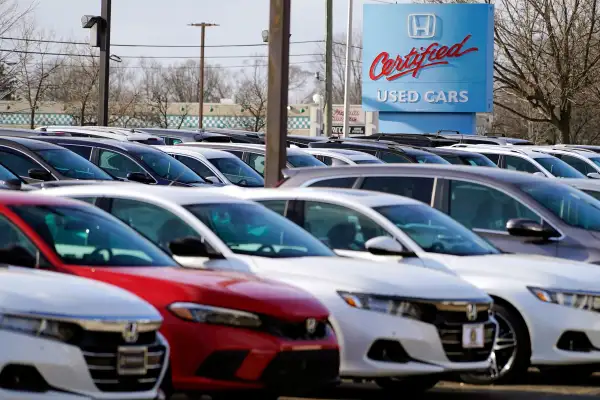Average Used Car Prices Soar to Nearly $30,000

Car buyers just can’t seem to catch a break. Average prices for new and used vehicles continue to skyrocket. Meanwhile, the auto industry is raking in record revenues despite selling fewer vehicles.
The average used car sold for a whopping $29,969 in December 2021, according to data from the auto research and buying site Edmunds shared with Money. That's up from an average of $23,185 one year prior, for an increase of nearly 30%.
According to data released this week by Kelley Blue Book (KBB), the price of the average used car — which has more than 69,000 miles — was slightly lower in December 2021 than the figure from Edmunds. But it's still very expensive in the grand scheme of things, with the average used car running $28,105.
As for new vehicle car prices, they're soaring to new highs as well. The average price for a new vehicle in December 2021 was $47,077 according to KBB. That marks the ninth consecutive month of price increases and the highest price ever recorded by the auto research company.
By all accounts, 2022 will be another very challenging year for car buyers. Prices are likely to keep rising, with the average costs for used and new cars creeping closer to $30,000 and $50,000, respectively.
“These increases are changing the marketplace and are also likely changing who can afford to buy,” says Cox Automotive Senior Economist Charlie Chesbrough in a webcast released Friday. Cox Automotive is the parent company of Kelley Blue Book.
For new vehicles, prices in December 2021 are up about 14% from the previous year, an increase of $5,742, according to KBB. Compared to the previous month, that’s a 1.7%, or $808, price increase.
The average sales price for used cars jumped $536 from November 2021 to December 2021, KBB reported. In December 2020, used cars sold for $21,979, on average. In other words, used vehicles were $6,126 cheaper roughly a year ago.
What’s more, on average, new vehicle buyers spent between $900 and $1,300 above the sticker price in December 2021, depending on the type of vehicle.
The drastic increase in car prices has contributed to the overall 7% inflation rate for consumer goods, with used car and truck prices up 37% over the past year, according to separate data from the Bureau of Labor Statics.
What’s behind high car prices?
According to industry economists, the pandemic has severely mucked with the supply of new vehicles. That, in turn, sent consumers flocking to purchase used vehicles. Now, the supply of new and used vehicles alike is low. So the prices for both continue to rise.
More specifically, the microchip shortage in the summer of last year drastically affected the amount of new vehicles that were arriving on the lots. Manufactures often decided to funnel their limited microchips into making higher-end vehicles with higher profit margins to compensate. As a result of focusing on luxury vehicles, fewer affordable options have been available at dealerships, and sales prices are ballooning.
In December 2021, the average buyer paid nearly $65,000 for a new luxury vehicle, whereas the average non-luxury vehicle cost about $43,000, per KBB. Average prices have soared particularly high for certain manufactures. For example, the average new vehicle transaction price across all makes from Tesla Motors and General Motors were 20% higher in December 2021 than a year prior.
Despite limited supply and fewer cars being sold, auto industry revenue is way up.
“The rise in vehicle prices is offsetting the loss in sales volume,” Chesbrough said.
In 2021, industry revenue reached $649 billion, which is nearly $100 billion higher than 2020 and more than 2019 revenue by nearly $2 billion.
And that’s with nearly 2 million fewer vehicles sold in 2021 versus 2019, according to Cox Automotive data.
“The market right now belongs to sellers,” Chesbrough said. “As a result, vehicle buyers looking for good deals will be challenged.”
More From Money
Gas Prices Will Soon Drop Below $3 a Gallon: Government Forecast
